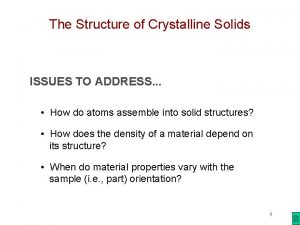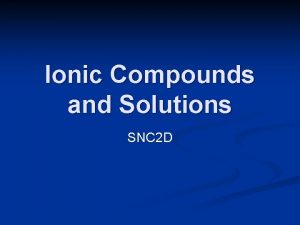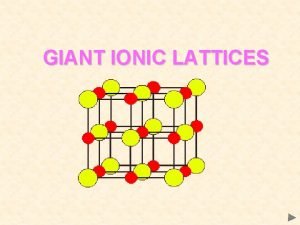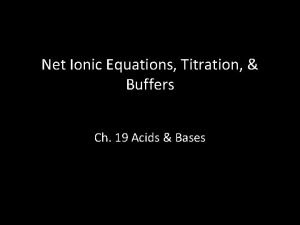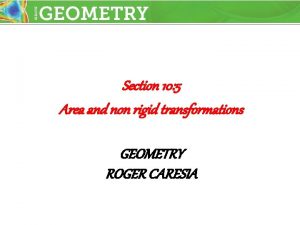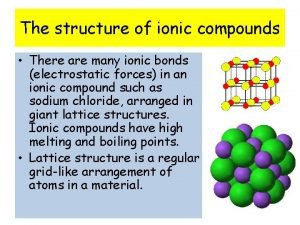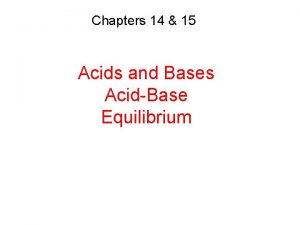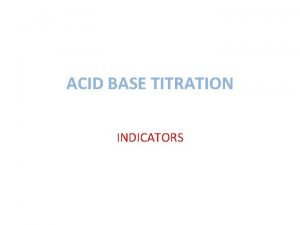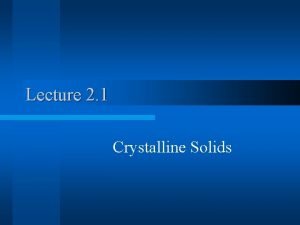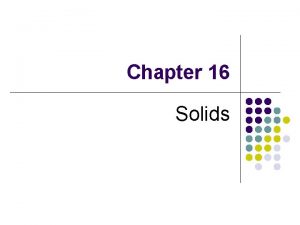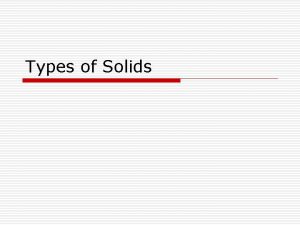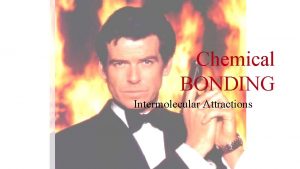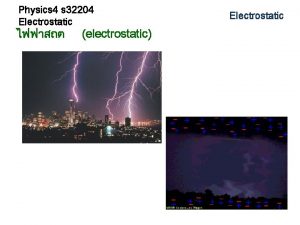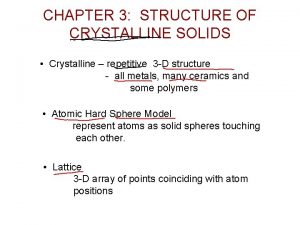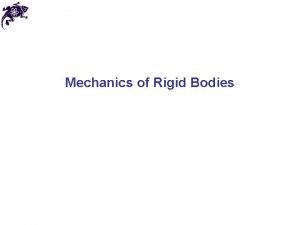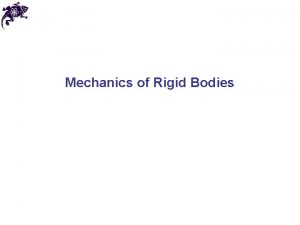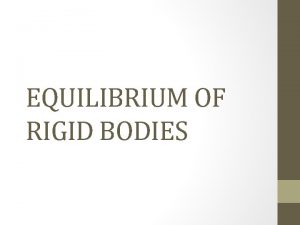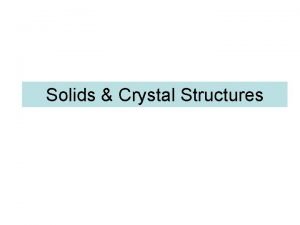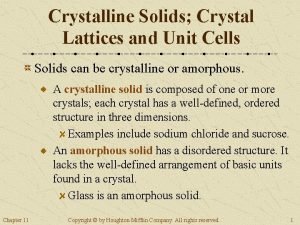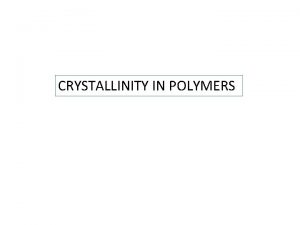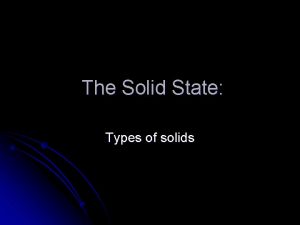Ionic Solids Characteristics Strong Electrostatic Attractions Rigid crystalline
















- Slides: 16

Ionic Solids Characteristics Strong Electrostatic Attractions Rigid crystalline structure Ionic Solids Conductivity Relatively High Melting Point Yes No In the solid phase Hard, brittle solids Formed from a bond between a metal and nonmetal In the molten or aqueous phase

The First Couple • # 1) Energy is released when bonds are formed. Energy is absorbed when bonds are broken. • #2) As a bond forms the PE decreases. • #3) Energy is released -> stability increases • #4) Two atoms combine to form a molecule, bond formed, energy is released

#5 Which electron-dot diagram represents H 2? Both hydrogen’s will equally share their valence electron H H

#9) In which compound do the atoms have the greatest difference in electronegativity? (1) Na. Br |0. 9 – 3. 0| = 2. 1 (2) Al. Cl 3 |1. 6 – 3. 2| = 1. 6 (3) KF |0. 8 – 4. 0| = 3. 2 (4) Li. I |1. 0 – 2. 7| = 1. 7

#13) Given the reaction: M + 2 H 2 O -> M(OH)2 + H 2 The metal represented by M is most likely a metal from Group M(OH)2 The subscript of 2 on the hydroxide came from the charge on the metal (M). +2 -1 M (OH) So the Metal (M) must be from Group 2 because of its +2 oxidation state!

#16) Element X has an electron configuration of 2 -8 -3. This element will combine with the phosphate ion to form a compound with the formula 3 Valence e-’s means that is will have an oxidation state of +3 +3 X (PO 4) -3 Criss Cross w/out charges X 3(PO 4)3 3 Reduce to Lowest Ratio X (PO 4) 3 From Table E: phosphate has a -3

#33 a. b. H H c. 1 Mg + H 2 is nonpolar and H 2 O is polar, like dissolves like, therefore H 2 will not dissolve in H 2 O. 1 H 2 SO 4 1 H 2 + 1 Mg. SO 4

#34 a. HNH H b. H HNH H +

#35 a. b. H Cl + H Cl c. H-Cl is polar, water is polar; like dissolves like

#36 a. N N OR N N b. N 2 is very stable, unreactive because of triple bond (a lot of energy was released when this bond was formed).

#6) Group 1 metals are highly reactive and form stable compounds. #7) Na 1 s 22 p 63 s 1 Will become [Na]+1 Na Cl 1 s 22 p 63 s 23 p 5 Cl 1 s 22 p 6 Ne Will become 1 s 22 p 63 s 23 p 6 Ar Cl -1

#8. Radon is a group 2 (metal), it wants to lose its 2 valence electrons to a nonmetal. 1) Iodine – nonmetal, wants to gain 1 e 2) Fluorine – nonmetal, wants to gain 1 e 3) sodium – metal, wants to lose 1 e 4) calcium – metal, wants to lose 2 e. Of the 2 choices that want electrons choice 2 is more reactive, larger electronegativity, than choice 1. Fluorine is the answer (choice 2).

#10) Which compound would most likely have the greatest ionic character? (1) CO |2. 6 – 3. 5| = 0. 9 (2) KF |0. 8 – 4. 0| = 3. 2 (3) Ca. O |1. 0 – 3. 5| = 2. 5 (4) Li. H |1. 0 – 2. 1| = 1. 1

#11) Given the reaction H 2 + Cl 2 → 2 HCl • Bond Breaking requires/absorbs energy. • Bond Formation releases/emits energy. The H 2 and Cl 2 bonds are broken – requires energy! The HCl bond is formed- releases energy! ü The answer is choice (4) the forming of the HCl bond releases energy

#12) Noble gases have the most stable electron configuration, choice 1 (Ne). #14) In order for the electrons to have been transferred to Oxygen, the oxygen will have to be the most electronegative element and the ionic character of the compound would be 1. 7 or greater. (1) CO 2 (2) N 2 O |2. 6 – 3. 5| = 0. 9 |3. 0 – 3. 5| = 0. 5 (2) NO 2 |3. 0 – 3. 5| = 0. 5 (4) Na 2 O |0. 9 – 3. 5| = 2. 6

15) Compounds including polyatomic ions have covalent bonding within and ionic bonding to the metal outside the parenthesis (brackets). Ca 2+ O O SO O 2 -
 Polycrystalline solids
Polycrystalline solids Bcc apf
Bcc apf Electrostatic attraction
Electrostatic attraction Ionic lattices
Ionic lattices Crystal solid and amorphous solid
Crystal solid and amorphous solid Ephesians 6:10-20 nkjv
Ephesians 6:10-20 nkjv Net ionic equation for strong acid and strong base
Net ionic equation for strong acid and strong base 10-5 area and nonrigid transformations
10-5 area and nonrigid transformations Rigid and non rigid dams
Rigid and non rigid dams Irrational exponential function
Irrational exponential function Brittleness of ionic solids
Brittleness of ionic solids Vo cation and anion
Vo cation and anion Strong acid-strong base titration indicator
Strong acid-strong base titration indicator Weak acid strong base titration curve
Weak acid strong base titration curve How to remember strong acids and strong bases
How to remember strong acids and strong bases Strong acid-strong base titration indicator
Strong acid-strong base titration indicator Strong acods
Strong acods

